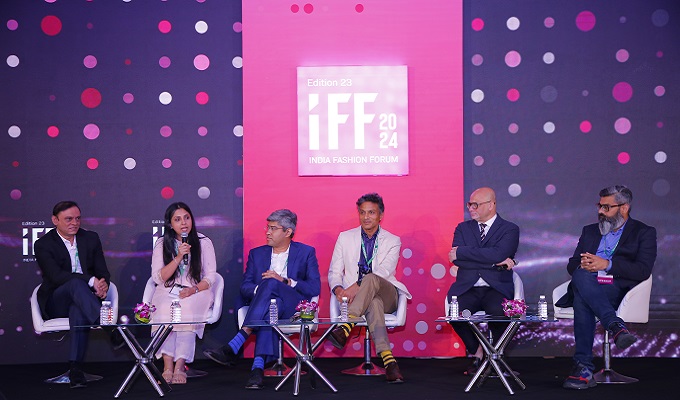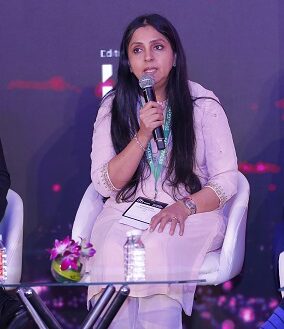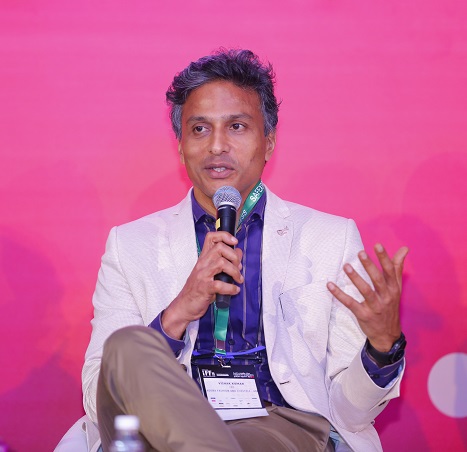These are transformative times for the business of fashion. Consumer behaviours, digitalisation, discounting impact, supply chain snags and sustainability demands are challenging us.
“The larger ecosystem has started terming the fashion business as ‘difficult’, whereas it was seen a couple of decades back as an area of immense opportunity delivering secular growth. It is time we rethink, reimagine, and remodel our industry and become a great force again. It’s time to shake off what-has-been and give life to the next Golden Age of Fashion Creation,” said Shailesh Chaturvedi, MD & CEO, Arvind Fashions & Convenor, IFF 2024, at a session he was moderating at India’s largest fashion retail intelligence event.

The power-packed panel included Rohit Ramesh, Managing Director & Partner, BCG; Suparna Mitra, CEO, Titan Watches & Wearables; Gopal Asthana, CEO, Tata CliQ; Vineet Gautam, CEO, BESTSELLER India; Vishak Kumar, CEO, Madura Fashion and Lifestyle – ABFRL.
Suparna Mitra started the discussion with a comment on how the business of fashion has become difficult.

“Things have fundamentally shifted over the last five years according to what the consumer wants. The Covid era was a complete disruption, but once people emerged from the pandemic, they started re-experiencing the joys of fashion. However, their demands changed, the generation changed and correspondingly the whole D2C startup environment was coming up,” she said.
She said that it was time to understand customer behaviour, to understand what the consumer wants right now, and this is not the traditional consumer who’s been buying for 10 or 15 years, but the new age, the younger consumer.
“This is why there is a pricing challenge. Since people don’t know what their consumers want, they make thousands of everything and eventually are left with unsold stock and then have no choice but to discount,” she stated.
Gopal Asthana chimed in here saying, “I feel that in an e-commerce business, a consumer is only looking for a discount because if he/she didn’t want a discount, they would just go to a physical store and buy fashion. However, I didn’t want to do what others were doing so I started thinking of how I can have more full prices in the business?”
He decided not to go to big companies and ask them to give Tata CliQ discounted inventory, but instead asked them to launch new collections on his platform alongside their store launch. In the beginning, he faced many issues – technology and brands being uncomfortable with selling online at discounted prices. But he found support from industry colleagues and eventually his business idea caught on.

“For example, 100% of business on brands like Trent on Tata CliQ is at full price, aside from when it’s sale season. So, I feel, some customers are willing to buy from us at full prices and there are various reasons for this – fashion is changing every day, inventory cycles are longer, and 65% of the population is less than 35 years of age – Gen Z – which wants something new every day,” he stated.
Asthana added that one way of developing loyalty for brands amongst consumers was to create a lot of content around the product and the brand, so much so that the customer waits for the new launch. “You don’t have to discount products if you create a buzz around them.”
Bringing Differentiation to the Consumer
Vishak Kumar said that as retailers, they owed it to consumers to create, to bring differentiation, newness, and excitement and to make every product worth the consumer’s while, to make them look forward to opening that wardrobe and picking up something that will make their day better.

On discounting, he said that one of the reasons fashion was associated with higher discounts was the fixed high-cost culture. “I think all of us have a responsibility to work with landlords, with malls, to find ways by which this fixed cost can be calibrated better, either with revenue shares or by making sure that there is a method in this madness of having a high fixed cost,” he said.
“How do you correct for some of these anomalies and find a business model with malls, with real estate players, which makes for a semblance of normalcy?” he asked. He said just before Covid hit, he had met with major retailers – offline and online – and told them that he wanted to work towards lower discounting. “It’s now time to re-visit this thought since we are well past the pandemic.”
Vineet Gautam agreed saying, “I think the challenge in India is that everyone is chasing capital. They are chasing valuations and valuations fundamentally in this country are today run on top line and EBITDA. There’s no discussion of depreciation, there’s no discussion of the cost of capital going in and hence we keep growing the business at costs that are not sustainable, rental models that are not sustainable, models of shop-in-shop businesses. And we are all party to this because it’s a competitive world.”

But fundamentally, he said, what BESTSELLER does differently is to think of who is looking at inventory.
“We need to check our inventory levels and inventory is the biggest killer. It is blocking cash, it’s increasing discounting, it’s taking gross margin and at the end of the day, the customer comes and wants a discount. He says, ‘Why should I buy something at this price when 15 days later there will be a sale and I will get it at a lower price’. So, we all need to see how we want to run our businesses,” he said.
“So, at the end of the day, we are continuously creating an ecosystem of unsustainable businesses in this country,” he added.
Creating Value
Rohit Ramesh of BCG, weighed in here saying that growth is good. “However, revenue growth drives value only in 15% of all companies that are outstanding value creators. So, revenue growth is not value-creating. If I see revenue growth plus EBITDA margin improvement, that correlation goes from 16%-17% to about 35%-40% and this growth gives you value creation. So, how does one build a sustained value creation? And then there is sustained capital efficiency. When you add all together – revenue growth, EBITDA margin growth and return on capital efficiency – you get a 70%-80% correlation and that is sustained value.

Value creation in fashion has been lagging because fundamentally it’s an oversupplied market globally. There’s so much supply and consumer demand is switching and so everyone is discounting because of the way the operating model is set up,” he explained.
“When you discount, you give up EBITDA and therefore you don’t have value-creating growth. When you have so much inventory that you give up return on capital, you don’t have value-creating growth. So growth for the sake of growth doesn’t help,” he concluded.



